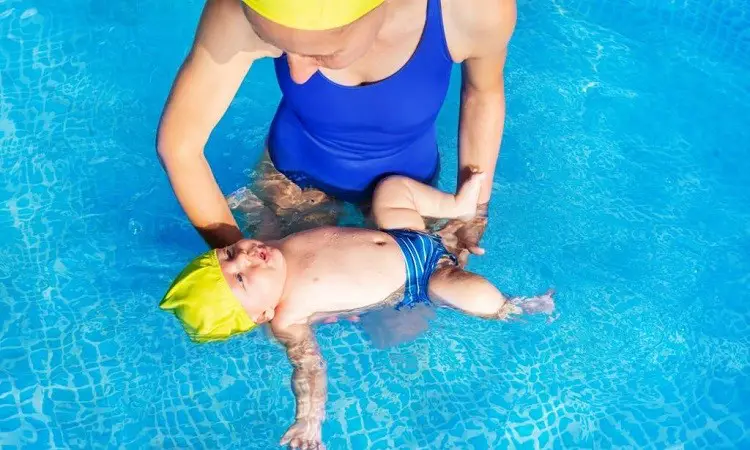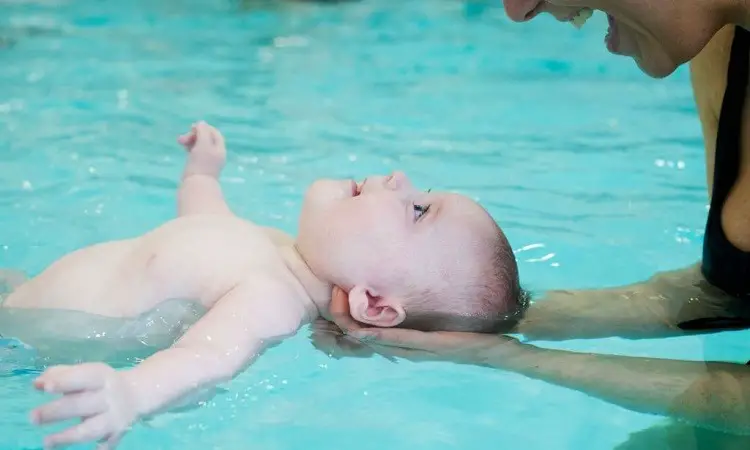The body system of a baby is so delicate that little contamination, either from bacteria or chemicals, can jeopardize their health.
If you intend to train your baby in swimming, questions like when can a baby go into a chlorine pool come to mind.
Generally, babies can begin swimming as early as two months old. But since all babies are not the same, physicians recommend waiting until your baby is at least six months old before taking them swimming.
Read through to know when a baby can go into a chlorine pool and a host of other things about taking babies swimming.
Table of Contents
- When Can a Baby Go into a Chlorine Pool?
- Safety Precautions
- Where Can a Baby Swim?
- Swimming Clothes for Babies
- Health Benefits of Going into a Pool with Your Baby
- Conclusion
When Can a Baby Go into a Chlorine Pool?

If you’re a new parent, you can admit how delicate your baby’s skin is. Little things like the wrong fiber or oils can irritate their skin quickly.
This is why it’s advisable to use unscented soaps and creams for them to reduce the chances of skin reactions or sneezing.
Chlorine, on its own, is a strong chemical used to treat water. If the level is too high in water, it can cause harm to the eye, nausea, and skin irritation to both adults and children.
Even as an adult, you’re very likely to develop skin reactions to excess chlorine, not to mention a baby’s soft skin.
Notwithstanding, it is still safe for babies to swim in chlorine-treated pools.
While swimming is a good way of improving body coordination and flexibility and also a form of relaxation, it is not advisable to put your newborn in a pool because babies can drown in waters as shallow as 5cm.
Therefore if you intend to teach your baby how to swim, have an adult watch over him.
But when can a baby go into a chlorine pool? On average, babies can begin swimming as early as two months old. But since all babies are different, in most cases, pediatricians recommend you wait until your baby is about six months old or can hold its head up on its own (around 4 or 6 months).
So watch your baby’s development index. Watch how balanced your baby is and how strong his neck supports his head without falling.
It is safer to wait until your baby begins to sit and crawl. At this age, the baby has mastered hand and leg coordination and can adequately support his head without any support from an adult.
Many parents, however, cannot wait until their babies start crawling around this time. In this case, you can as well teach your baby how to swim so long as you keep an eye on him.
Safety Precautions
Once it involves babies, always be mindful of the environment and what you expose them to.
1. To prevent colds and fevers in babies under six months, ensure the pool is heated to about 32°C.
Even at six months, do not let your baby get into a freezing pool, continually heat it to a higher temperature and gradually adjust it as the baby grows.
In some cases, babies who try swimming for the first time become afraid of the cold, and instead of learning how to swim, they develop a fear of pools.
2. If you have a private pool, build a fence higher than your baby’s reach around the pool.
Babies can be mischievous and fast and may escape to the pool area within minutes without your notice. Without a fence to protect them, they’d eventually dive in and drown if no adult was around.
3. Do not allow your baby to enter the pool immediately after eating. It may cause them to throw up and affect their breathing.
4. Ensure your baby is not soiled with poo before entering the pool. Please take out the diaper before putting him in the pool.
5. If you’re using any floaters, guide them gently to prevent them from tipping the baby’s head over. The movement of the baby’s legs can be so uncontrollable that if you don’t pay attention, it’ll tip over in the pool.
6. As a new mom, don’t get into the pool until you’ve stopped bleeding. This usually takes up to 6 weeks after delivery.
Getting into the pool while still bleeding can contaminate the pool for others and introduce bacteria into your system.
7. Don’t put the baby in an untreated pool. Different microorganisms grow in water; it doesn’t take long before they start to grow.
8. Treat the pool for a few days before putting your baby in it. This also implies that public pools aren’t ideal for babies below two years since you can’t guarantee their maintenance practice.
Read: Newborn Safety Checklist
Where Can a Baby Swim?
If you’re a beginner, wait to start your first swimming lessons in a large pool.
A bathtub or a large basin is fine for babies below six months. That way, they’re not overwhelmed by the water, and you can easily control them in the water.
After the tub, gradually introduce them to a private pool or any public pool you’re sure of their pool maintenance. A lot of filth is left in public pools.
Some people pee, spit or fart in public pools, and for a baby, such contaminated water can make it fall sick. In a private pool where you can treat the water yourself, you can guarantee that the water is clean and safe for your baby.
The disadvantage of taking swimming lessons at a public pool is that they need to properly maintain their pools, which is why starting at home is better.
Swimming Clothes for Babies
Like every other occasion, swimming also has its attire for babies. Here is a list of some swimming clothes for babies.
Swim nappy
The nappies come with snug-fitting legs and waistbands to hold your baby’s poo if he takes a dung mid-swim. They are not designed to contain urine.
Swim nappies come in two different types
- Disposable swim nappies: Similar to normal disposable nappies, they won’t swell up in the water.
- Reusable swim nappies: They are made from stretchy bathing suit material, which allows water to escape while still containing solids inside. Some have an inner water-proof layer – like plastic pants, while others have an inner mesh layer.
Towel
A towel is essential for after the swimming lessons. You feel cold when you get out of the pool, and if you don’t have a towel to wrap around your baby, he will likely catch one too.
Other swimming items include
- A changing mat for changing soiled waistbands.
- A nappy bag to contain the clothes.
- Snacks or a food pack
- Floaters (optional)
Health Benefits of Going into a Pool with Your Baby
Taking your infant to the pool can be stressful if you are a new parent.
It is essential to allow your baby to see other faces and hear other voices as early as two months old to develop their speech and language.
Bringing your baby into the pool allows you to socialize and give your baby a chance to see other faces and hear other voices.
Norwegian researchers found that 5-year-olds who had learned to swim as infants had better balance and grasped things better than those who hadn’t.
The pool can make your baby more comfortable in the future since they are less likely to fear large bodies of water as they grow up.
Read Also: Baby accidentally drinks bathwater (Helpful Tips)
Conclusion
Apart from the information in this article, to determine when a baby can go into a chlorine pool, please check with your healthcare provider to be sure that your baby has no allergies that the water can trigger and is healthy enough to go into the water.
